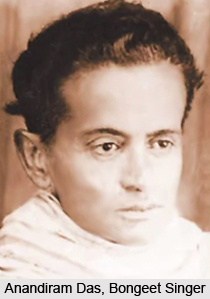 Bongeets are a category of Assamese folk music, very closely resembling the `Bihugeets`. They are like the woodmen`s ballads of the West. The natural haunts of rural landscape are the source of these songs. Engaged as he is in harvesting his field, the peasant sings. Such songs are sung by farmers while rearing `Endi` and `Muga` cocoons in the mulberry grove, or drawing the fishing net in silent lagoons or leisurely paddling his boat in the stream. Primarily, these are the occasions when the peasant gives his soul away to music. And these are the instances when the Bongeet is born.
Bongeets are a category of Assamese folk music, very closely resembling the `Bihugeets`. They are like the woodmen`s ballads of the West. The natural haunts of rural landscape are the source of these songs. Engaged as he is in harvesting his field, the peasant sings. Such songs are sung by farmers while rearing `Endi` and `Muga` cocoons in the mulberry grove, or drawing the fishing net in silent lagoons or leisurely paddling his boat in the stream. Primarily, these are the occasions when the peasant gives his soul away to music. And these are the instances when the Bongeet is born.
The term `Bon` implies wilderness while `geet` means songs. Bongeet songs are quite favourable in the Assamese society since ancient times and these songs are mostly romantic songs, which are sung by the local youngsters of Assam. The central idea of Bongeet is to convey the natural grandeur of nature, which includes songs describing the hues of dense forests, birds, flowers and animals. Certain songs of Bongeet express the subtle emotions of tragedy, anxiety, love and hatred and are devoid of religious influences.
Mentioned below are some lines extracted from a popular Bongeet:
"My mind turns from the field, O darling, Of my home I grow weary, With the buoyant fleece I strive to fly, For without thee my life is dreary. Bright is the day with sunbeam, The night with mellow moonbeam; Brighter still is my darling`s face, Shining in the full-moon`s gleam."
In these songs, there is usually noticed a certain melancholic mood as well as a strange mystic inclination. Romantic elements can be seen expressed here in their purest form. These popular songs are the inevitable results of moments of self-absorption and free emotional abandon. There is often a measure of dreamy imaginativeness in these songs which adds to their intensity.
This article is a stub. You can enrich by adding more information to it. Send your Write Up to content@indianetzone.com




















